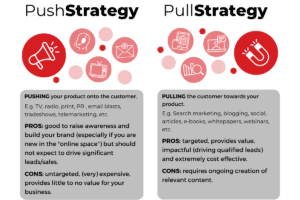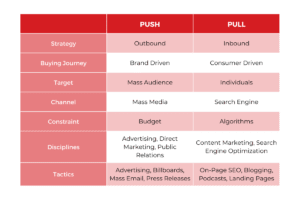In the world of marketing, there are two main approaches: push and pull. Push marketing focuses on making a product or service available to consumers, while pull marketing focuses on attracting consumers to a product or service.
Each approach has its own advantages and disadvantages, and the best strategy for a business will depend on several factors. In this blog post, we’ll take a closer look at how each works, the pros and cons of push and pull marketing, and help you decide which form is better for your brand.
Push vs pull marketing examples
Push and pull marketing strategies are all about how you reach your target market. Push marketing is generally more interruptive and aggressive, while pull marketing is more subtle and engaging. Both have their own advantages and disadvantages, which we’ll cover in more detail later.

What is push marketing?
Push strategies involve “pushing” your product or service onto your customer base. Examples of push marketing strategies include:
- Television commercials or YouTube ads
- Print ads
- Popup ads and banners
- Paid social media ads and promotions
- Direct mail
- Google and Bing ads, and
- Actually selling face-to-face at a trade show or in a retail setting
Because push marketing relies on interruptive methods like pop-up ads and banner ads, it can be very effective in getting people’s attention. However, because these techniques can be perceived as intrusive and annoying, it’s not always the best choice for building long-term customer relationships.
What is pull marketing?
Pull strategies, on the other hand, focus on “pulling” customers towards your product or service organically.
Examples of pull marketing strategies include:
- SEO (Search Engine Optimisation) – optimising your website content to attract the right kinds of traffic and offer a great user experience
- Content marketing
- Organic social media posts that offer genuine value and help you grow a following
- Lead magnets like tutorials, white papers, in-depth guides and ‘how to’ content
- Email marketing, and
- In a physical setting, running sales and promotions, offering discounts or loyalty programs, etc.
Because pull marketing is more engaging and less interruptive than push marketing, it’s often more effective in building long-term relationships with customers. However, because pull marketing takes longer to reach a wide audience, it’s not always the best choice when you’re trying to generate quick results.
Pros and cons of push marketing
Push marketing involves actively trying to persuade potential customers to buy a product or service. The main goal of push marketing is to create a sense of urgency and encourage people to take action immediately.
This can be done through all sorts of tactics, like discounts, limited-time offers, and celebrity endorsements. Push marketing can be highly effective in raising awareness for a new product or service, and can help to build brand loyalty and repeat customers. Used wisely, push marketing strategies are also a good technique if you’re trying to get the word out to a very wide audience.
However, while push marketing can be effective in getting people to take notice of a product or service, it can also be perceived as aggressive or, well, pushy.
Additionally, because push marketing relies on creating a sense of urgency, it can often backfire if people feel like they’re being pressured into buying something.
It can also be expensive, especially if you’re trying to outcompete established brands with lots of money to splash on ads!
Ultimately, whether or not push marketing is successful depends on the product or service being promoted, the target audience, and the overall tone of the campaign.
Pros and cons of pull marketing
Pull marketing is a strategy that focuses on making it easy for customers to find and buy your product or service. Unlike push marketing, which involves actively promoting your products to potential customers, pull marketing relies on creating an effective online presence and letting customers come to you.
This can be a more cost-effective approach, since you’re not spending money on “hit or miss” advertising or other forms of active promotion. Instead, you’re investing in creating a strong online presence and making sure your products are easy to find and purchase.
This can be done through various means such as advertising, SEO, and content marketing. While it may take more time and effort to attract customers using pull marketing, the benefits can be well worth it.
Also, pull marketing allows you to build a relationship with your customers. You are not just trying to make a quick sale; instead, you are working to create a loyal customer base that will keep coming back.
Pull marketing techniques are generally more cost-effective than other methods, and can also provide you with valuable data about your customers that can be used to improve your products or services. For instance, comments on your blog posts or social media pages may alert you to new challenges your target audience is experiencing – which means you can start providing solutions to them.
Overall, pull marketing strategies can be an extremely effective way to grow your business. On the downside though, you shouldn’t expect pull strategies to bring in hundreds of new customers overnight.
Rather, this approach focuses on the long-term growth of your business. This means it’s not always the best choice for campaigns aimed at very rapid, short-term results.

What is the best marketing strategy for my business?
The answer, as always, is “it depends.” Keep in mind that both of these strategies can meet prospects at a specific stage in the buyer’s journey. If you’re looking to increase brand awareness or reach a new audience, pull strategies may be your best bet. But if you’re trying to generate leads or make sales quickly, push strategies might be more effective.
It also depends to a large extent on the nature of your business. For example, companies that sell unique or niche products may benefit more from push marketing, as they need to make sure potential customers are aware of their product. On the other hand, businesses with mass appeal may do better with pull marketing, as they can rely on consumer demand to bring customers to them.
Ultimately, the best marketing strategy for a business is the one that most closely aligns with its goals and target audience. What are you trying to achieve? Once you’ve answered that question, choosing the right strategy becomes a lot easier.
From our experience, pull marketing is a more efficient and effective way to reach potential customers and sell your product or service. This is because you’re reaching customers who are already interested in what you have to offer. By contrast, with push marketing, you may end up wasting money on promoting your products to people who have no interest in them.
You should also consider whether an interest-focused or intent-focused strategy is better for your brand and audience. Find out more about this in our blog: Interest vs Intent – What marketing strategy is right for your business?
If you’re not sure which is right for you, or need help crafting a tailored marketing strategy that ticks both boxes, then Ruby Digital can help! If you’ve got questions about any of the marketing channels or strategies we discussed in this post, reach out and we’d be happy to answer them.




